The blood parrot cichlid is a distinctive and popular freshwater fish in the aquarium hobby, known for its bright colors and unusual body shape. This hybrid species, created from crossing various cichlids, doesn’t exist in the wild but has become a favorite among aquarists due to its vibrant appearance and relatively peaceful nature. Despite its small, oddly-shaped mouth, which can sometimes make feeding tricky, the blood parrot cichlid is not particularly demanding in terms of care.
In this guide, we’ll explore the fascinating origins of the blood parrot cichlid, the ideal tank setup, including required capacity and water temperature, as well as the best tank mates and feeding tips to keep your fish healthy and happy.
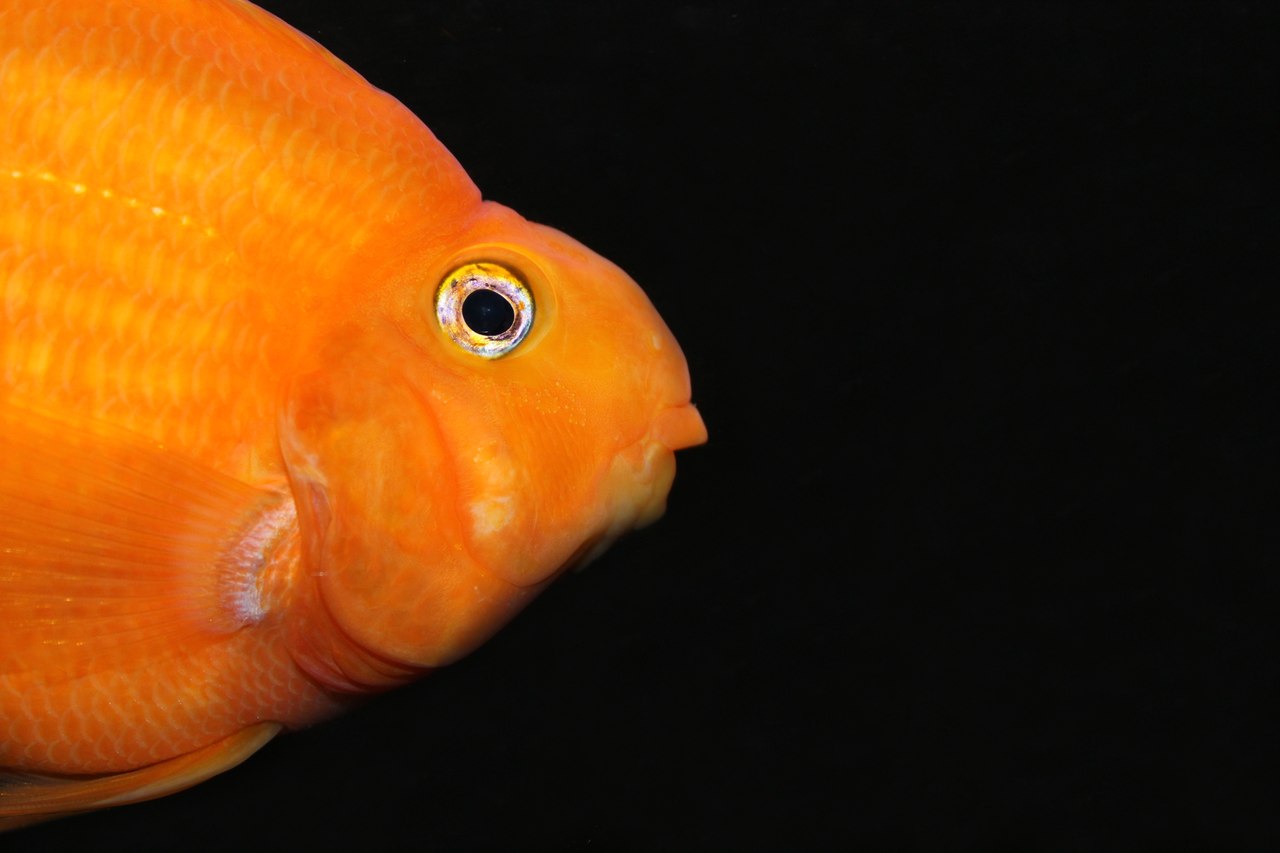
Contents
Habitat in the wild
The blood parrot cichlid is often absent from official fish catalogs, and its Latin name (Cichlasoma sp.) is indirect, offering little information about its true origin. The name “blood parrot cichlid” is purely commercial and doesn’t reflect the species’ hybrid background.
Cichlids are known for their ability to crossbreed not only within their species but also with other types of cichlids. This unique feature has led to the creation of various hybrids, though not all are successful. Many hybrids suffer from poor coloration or sterility, but exceptions like the blood parrot cichlid and flowerhorn have gained popularity due to their striking appearance and unusual traits. These hybrids result from artificial breeding.
The name “parrot” likely refers to the fish’s distinctive mouth shape, which may also resemble a marine parrotfish. However, parrotfish are a completely different genus that inhabits saltwater, whereas the blood parrot cichlid is a freshwater fish.
The blood parrot cichlid is believed to have been first bred in Taiwan, with its ancestors originating from Central and South American cichlids. However, the exact breeding process remains commercial classified information, and the parent species are often kept secret by breeders. It is generally thought that species such as the red devil cichlid (Amphilophus labiatus), the midas cichlid (Amphilophus citrinellus), and the severum (Heros severus) contributed to its lineage. These species were likely selected for their desirable traits, such as vibrant coloration, body shape, or temperament.
Three potential combinations of parental species include:
- Midas cichlid (Amphilophus citrinellus) and redhead cichlid (Cichlasoma synspilum)
- Red devil cichlid (Amphilophus labiatus) and banded cichlid (Heros severus)
- Red devil cichlid (Amphilophus labiatus), banded cichlid (Heros severus), and Cichlasoma “theraps”
The hybridization process involves crossing these parent species and then selectively breeding the offspring to emphasize desired traits, such as the parrot-like beak, rounded body shape, and vibrant coloration. This often requires multiple generations of selective breeding to perfect these characteristics.
Despite their popularity, blood parrot cichlids have sparked debate due to their unique physical challenges. These fish have a small, oddly-shaped mouth, which complicates feeding and makes it difficult for them to compete with other species for food. Additionally, they suffer from spinal and air-bladder deformities that affect their ability to swim properly. As a result, blood parrot cichlids cannot survive in the wild and are suited only for life in an aquarium.
There are ongoing ethical concerns regarding whether hybrids like the blood parrot cichlid and flowerhorn should be bred at all. While they are visually appealing, their physical deformities and potential health issues make them more vulnerable compared to other tank fish.
| Characteristic | Description |
|---|---|
| Scientific Name | No established scientific name; hybrid fish |
| Common Names | Blood Parrot Cichlid |
| Origin | Hybrid species created through selective breeding |
| Size | Around 6 to 8 inches (15 to 20 cm) in length |
| Lifespan | 10 to 15 years or longer with proper care |
| Body Shape | Round and compact with a humped back |
| Coloration | Various shades of red, orange, yellow, and white |
| Mouth | Small and angled upwards, resembling a parrot’s beak |
| Behavior | Generally peaceful, but individual behavior can vary |
| Tank Size | Minimum of 40 gallons (150 liters) for a single fish |
| Water Parameters | Temperature: 75°F to 80°F (24°C to 27°C); pH: 6.5 to 7.5 |
| Diet | Omnivorous; a balanced diet of pellets, flakes, and live/frozen foods |
| Compatibility | Generally compatible with peaceful tankmates |
| Breeding | Difficult due to hybrid nature; typically sterile |
| Special Considerations | Due to breeding practices, potential health issues and ethical concerns have been raised |
Description
Size
The fish itself is average-sized if compared to other cichlid species. On average, adult cichlids typically reach a size of around 6 to 8 inches (15 to 20 cm) in length.
However, its size also depends on several factors:
- Tank size – there is a direct correlation here – the larger the tank is, the larger fish you can grow.
- Tank conditions – in clean water with minimal nitrates content, provided regular water renew – the grows good.
- Feeding – the fish should have a diverse diet, desirably specialized food for cichlids (the main thing is to avoid overfeeding).
The blood parrot fish has a very small mouth and fins. The mouth has an almost triangular shape, and the lips don’t occlude completely, and often, it looks like a smile. The mouth opens only vertically and at a small angle.
The body of the blood parrot cichlid is short and rounded, a result of its spinal deformity, which also causes an air-bladder deformation that impacts the fish’s ability to swim. Due to this unusual body shape, the fish moves clumsily in the water, often struggling to maintain balance.
Its fins are small and straight, with the anal and dorsal fins sometimes extending into elongated, trailing shapes. In some cases, the tail fin is deliberately cut to enhance the resemblance to a heart, a variant known as the “love heart blood parrot.” However, this practice does not necessarily make the fish more graceful; in fact, it can limit the fish’s swimming efficiency even further.
Lifespan
Blood parrot cichlids typically live for 10 to 15 years in a well-maintained aquarium, though some individuals have been known to live even longer under ideal conditions. Proper care, including a suitable diet, clean water, and a stable environment, plays a significant role in their longevity.
Due to the severe anatomical and morphological changes caused by interspecific hybridization, these fish are unable to survive in the wild. Their altered body structure and deformities make it difficult for them to compete with naturally occurring fish species. However, in the controlled environment of a tank, they can enjoy a relatively long life despite these challenges.
Types of parrot cichlids
Blood parrot cichlids are typically red, orange, or yellow in color. However, due to their artificial origins, breeders have experimented with a variety of modifications. In recent years, a significant number of imported fish have been artificially dyed, with some even displaying patterns such as hieroglyphs, hearts, or letters. This process is painful for the fish, and many do not survive the procedure.
Traditional aquarists often disapprove of these practices, seeing them as unethical. Yet, the continued appearance of these fish in the market indicates a demand for such modified specimens. Additionally, some fish are fed with artificial dyes to enhance their colors, while others may exhibit unique patterns or even albino traits as a result of hybridization.
A large percentage of these fish are artificially dyed, a process that raises significant ethical concerns. There are two primary methods:
- Immersion in Dye Solution: In this method, the fish is first placed in an alkali solution to strip away the protective mucus layer on its skin, which helps guard against infections and injuries. Once the mucus is removed, the fish is immersed in a dye solution, and then placed in another chemical solution to stimulate the formation of a new mucus layer. This process is highly stressful for the fish and severely weakens its immune system, often leading to a high mortality rate during or after the procedure.
- Injection: This method resembles tattooing, where a needle is used to inject dye under the fish’s skin. The pattern is created over multiple injections, making the process extremely stressful and painful for the fish. The injection sites are prone to infections, so the fish are often kept in tanks with high levels of antibiotics to prevent death. However, the overall impact on the fish’s health is overwhelmingly negative.
There are also various types of parrot cichlids, each with distinct characteristics and colors. The complexity of their taxonomy, due to extensive hybridization, makes classification difficult. Some of the more commonly seen variants include albino parrot cichlids and jellybean parrots, each offering unique color patterns created through selective breeding.
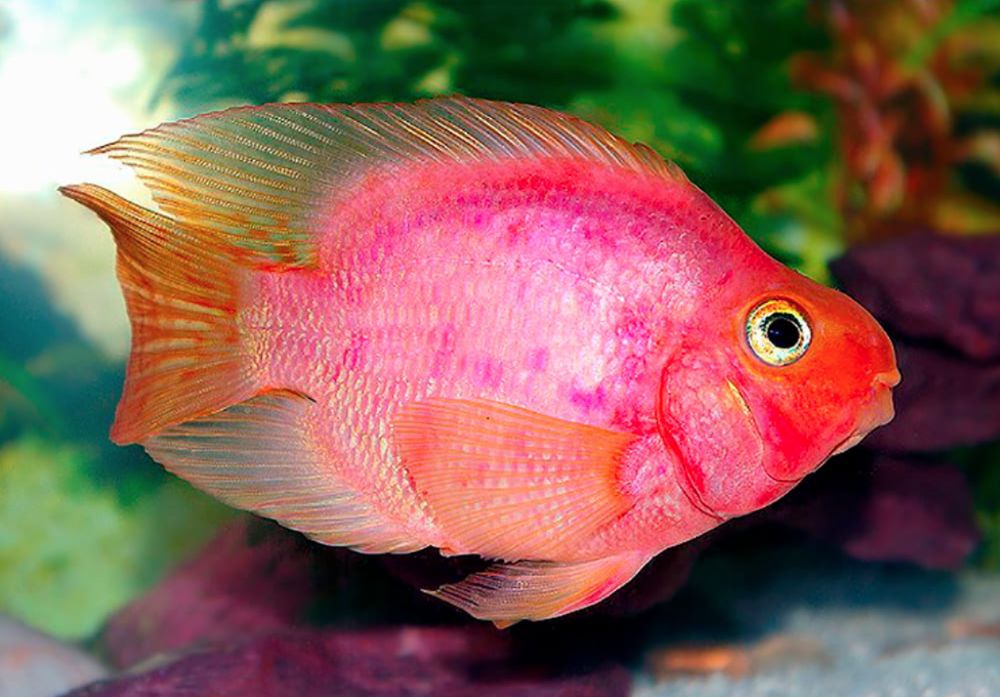
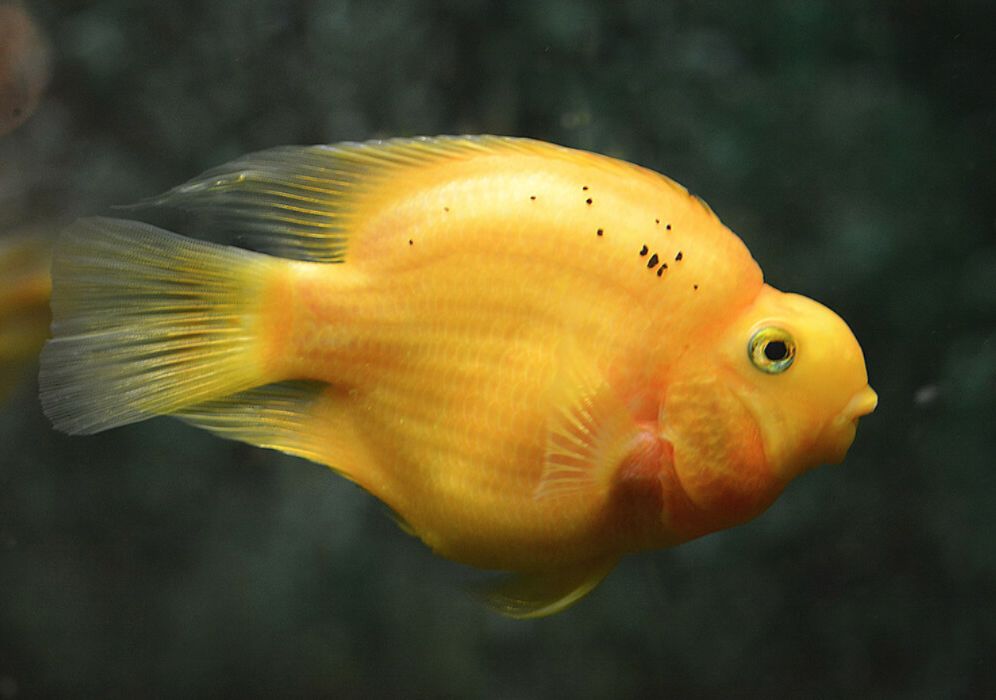

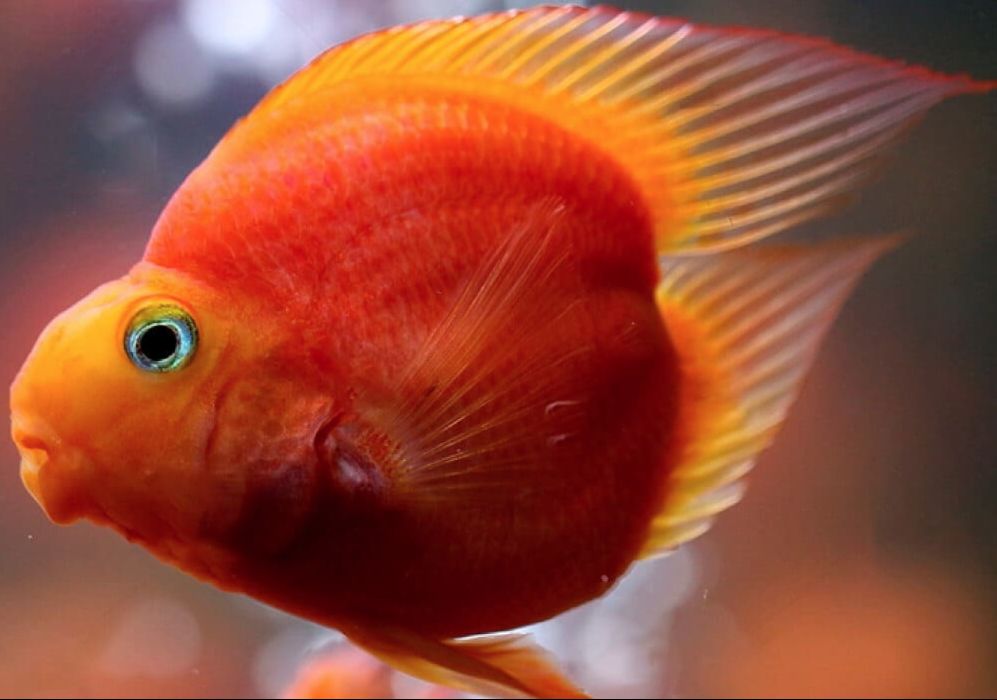
Difficulties in keeping
Blood parrot cichlids are suitable for both beginner and experienced aquarists, thanks to their generally peaceful nature. However, it’s important to avoid keeping them with aggressive tank mates, as this could lead to stress or conflicts. If you plan to house them with fish of similar size, be mindful that blood parrots can exhibit territorial behavior, especially toward other fish encroaching on their space.
Despite this occasional aggression, they are visually appealing, friendly, and engaging fish that make great additions to community tanks. Keeping several of them together can create a lively environment. During the spawning period, these cichlids exhibit fascinating behavior by digging holes in the substrate to lay their eggs. It’s amusing to watch them pick up small pebbles, swim away, and then spit them out near the hole to form a mound. This behavior is especially captivating for children, sparking curiosity and leading to countless questions as they observe the fish in action.
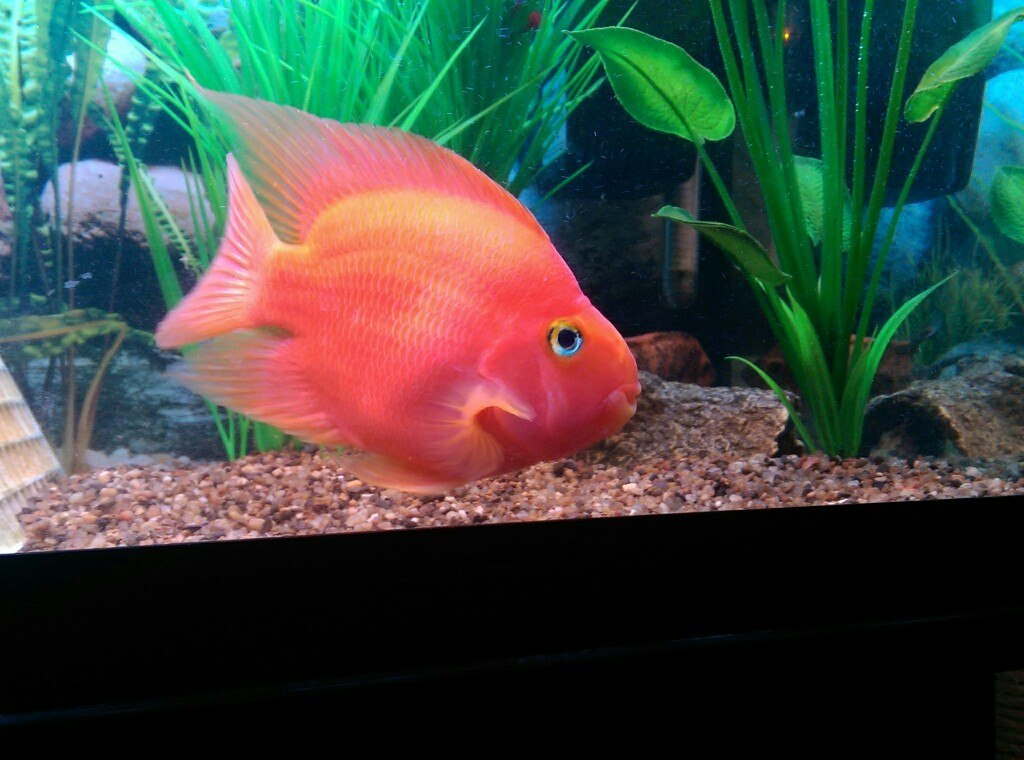
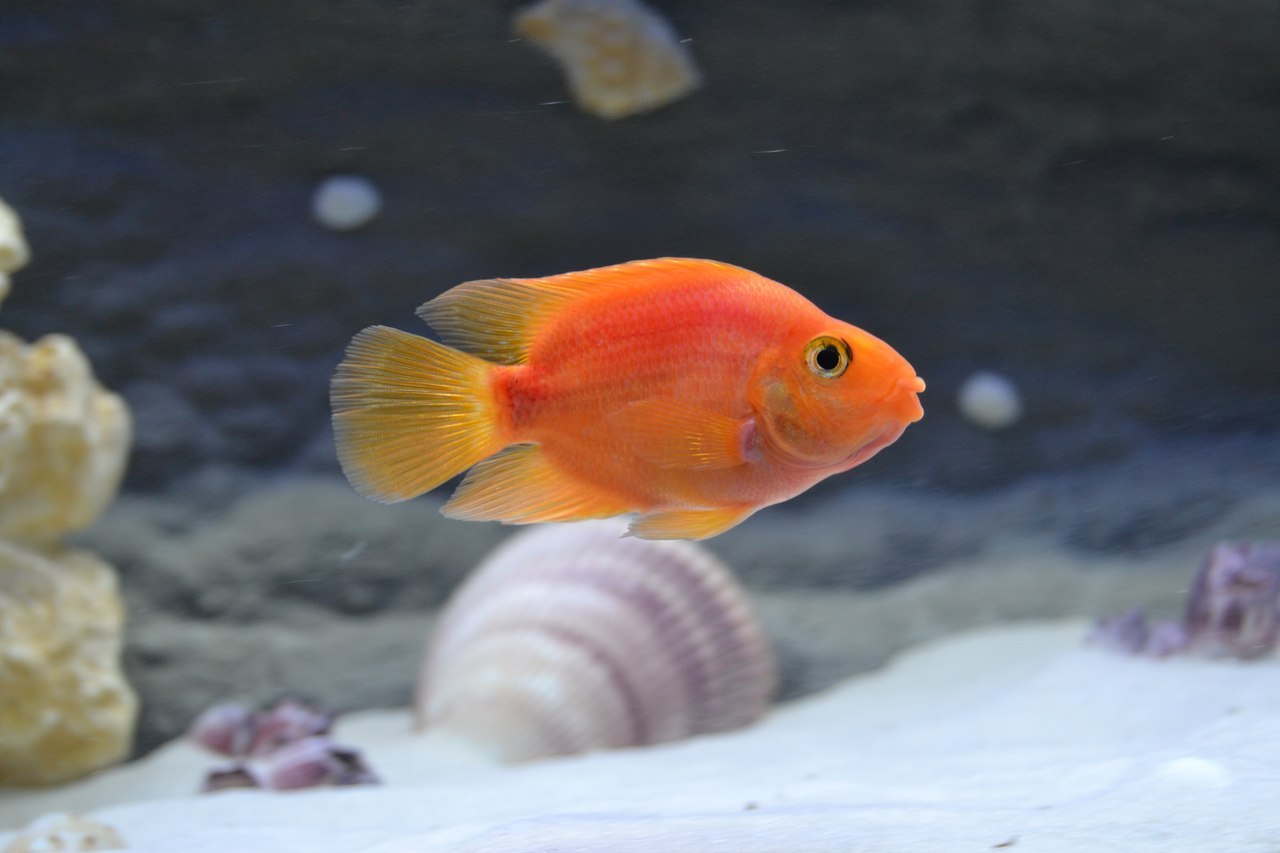
Care and keeping in a tank
Tank size
For a single blood parrot cichlid, a minimum tank size of 40 gallons (150 liters) is recommended. This provides sufficient swimming space and allows the fish to establish its territory.
If you plan to keep multiple blood parrot cichlids, a larger tank is required to accommodate their social dynamics and minimize aggression. As a rule of thumb, add an additional 20 gallons (75 liters) for each additional fish. For example, two blood parrot cichlids would require at least a 60-gallon (225 liters) tank. Providing plenty of hiding spots, plants, and decor will further help reduce territorial disputes and create a comfortable environment.
Water parameters
The blood parrot cichlid is relatively undemanding regarding tank water parameters. For optimal health, maintain the water temperature between 75-82 °F (24-28 °C), with a pH level around 7. The water hardness should be between 2 and 25 dGH, indicating a range from soft to moderately hard water.
Tank setup: decorations and plants
Blood parrot cichlids are timid fish that benefit greatly from having plenty of shelters in their tank. Initially, you may not see them often as they tend to hide when someone enters the room. It can take up to three months for them to adjust to their new environment and become more visible. However, it is crucial to provide shelters to prevent stress and potential health issues.
To help your blood parrot cichlid feel secure, include a variety of shelters such as flower pots, small castles, caves, and coconut shells. The fish prefers a rocky bottom with cavities and cracks for hiding. Since blood parrot cichlids are avid diggers, use a large-grained substrate to prevent injuries. Additionally, place large, smooth stones where you don’t want them to dig, and use heavy stones to anchor plants and create a flat area for spawning.
A glass cover is essential for the tank, as blood parrot cichlids can jump out, posing a risk of injury or death. Over time, as the fish become familiar with their caretaker, they may start taking food from your hand and spend more time near the front of the tank.
When it comes to tank plants, the blood parrot cichlid’s compatibility varies. Some fish may ignore plants, while others may damage them. To minimize plant damage, opt for stiff-leaved varieties like anubias, and ensure they are securely anchored with heavy stones to prevent floating. Place live plants in the background or along the tank’s sidewalls.
To reduce digging behavior, maintain the water temperature at or below 75°F (24°C). Elevated temperatures can stimulate digging as the fish prepare for spawning. Lower temperatures help reduce this behavior, as the fish are less likely to dig excessively when they are not in spawning mode.
Light
The light shouldn’t be very bright, and it’s better to select the lamps with red light spectrum prevailing. It makes the fish look more appealing. Under the lamps with blue spectrum prevailing, they look quite pale.
Filtration
Blood parrot cichlids are large fish that produce a significant amount of waste, so proper filtration is essential to maintain water quality. An external filter with adequate power is the best option for these fish, as it can handle the high waste load effectively. To maximize oxygen exchange and prevent dust accumulation, direct the filter’s water flow toward the surface of the tank. This creates surface agitation, which enhances gas exchange and keeps the water well-oxygenated.
If you notice your fish coming to the surface and breathing heavily, it may indicate a lack of oxygen in the tank. In such cases, consider adding additional aeration to ensure a stable and healthy environment.
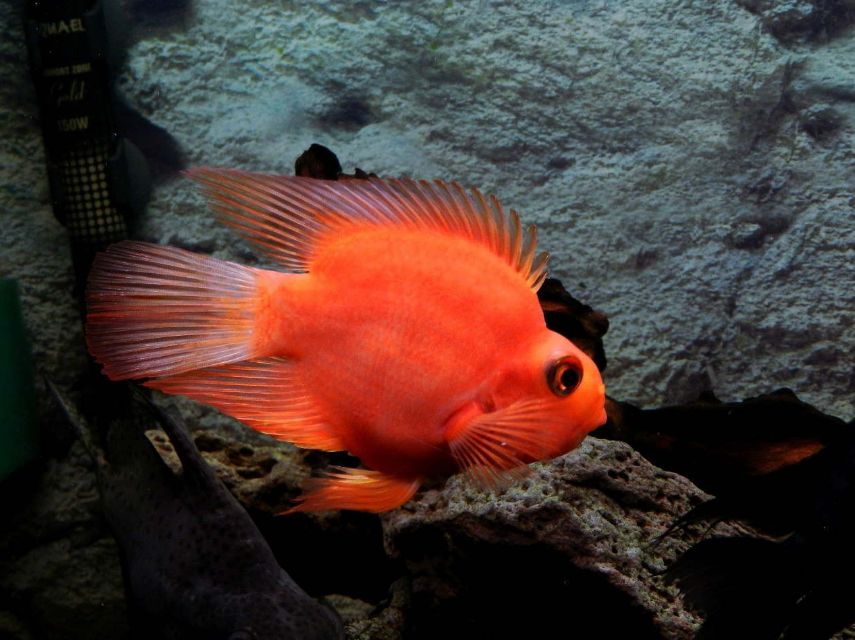
Diet
Blood parrot cichlids feeding has peculiarities due to two things – their unusual mouth and the necessity to support their bright coloring. Half of the food doesn’t get to their mouth, and they can’t really pick up the food from the tank bottom. They can take the food from the water surface, but they often miss it. To pick up the food leftovers from the tank bottom, you should keep some catfishes (like Corydoras julii, panda cory, pictus catfish, or banjo catfish). Otherwise, the leftovers will rot and poison the tank water quite quickly.
Although the fish can eat almost any kind of food in the tank, the best choice is high-quality artificial food made especially for blood parrot cichlids considering their feeding peculiarities. There was even developed special food for them, made as floating granules or pellets. These round pellets float on the water surface for a long time and are available for them to eat. It contains natural dyes to boost the fish coloring, which is visible just two weeks after you start feeding them with this food.
As an alternative, you can use full-fledged food for all cichlid types. It is rich in nutrients and contains concentrated natural coloring boosters. We should mention that blood parrot cichlids tend to overeat, so make sure you don’t overfeed them. It’s good to feed them several times a day with small food portions.
Tank mates
The number of blood parrot cichlids that can be kept together depends largely on their behavior, which can vary between individuals. Some may display aggression or territorial tendencies, while others are more peaceful. This variability makes it important to monitor their interactions closely.
For a single blood parrot cichlid, a tank of at least 40 gallons (150 liters) is recommended. If you plan to keep multiple cichlids, a larger tank is essential to reduce territorial disputes and ensure each fish has enough space. As a rule of thumb, increasing the tank size by an additional 10-15 gallons (38-57 liters) per additional fish is advisable.
A small group of blood parrot cichlids can be kept together in a spacious tank, but the number will depend on the tank’s size, the individual personalities of the fish, and how well they coexist. Providing plenty of hiding spots, plants, and décor can help minimize aggression by allowing each fish to establish its own territory. Always observe their behavior and be prepared to separate individuals if aggression becomes an issue.
You should bear in mind that though fish is a peaceful one, it is still a cichlid and not very small. Therefore, all small fishes in a tank it takes as food. So, you should forget about keeping such small fishes as guppy, platy, or neon tetra.
You should choose fish tank mates of the same size. If these are cichlids, they shouldn’t be aggressive – firemouth cichlid, kribensis will do. But cichlids like oscar fish, convict cichlid and flowerhorn are not. Also, the following average-sized fast fishes can share the tank with blood parrot: tiger barb, clown loach, emperor tetra.
Certain cichlid species known for their peaceful nature can be good tank mates for blood parrot cichlids. Examples include Angelfish (Pterophyllum scalare) and Keyhole Cichlids (Cleithracara maronii).
blood parrot: male vs female
Distinguishing between male and female blood parrot cichlids can be challenging due to their hybrid nature, which combines traits from different cichlid species. Their unique body shape further complicates identifying gender based on physical characteristics alone.
Blood parrot cichlids reach sexual maturity around one and a half years of age. During the breeding or spawning period, males may display more aggressive and territorial behavior. They might also exhibit brighter colors or intensify their existing coloration to attract females.
One physical difference that can help in sexing the fish is the shape of the anal cone. The female’s anal cone is pear-shaped and becomes more pronounced during spawning. Observing their behavior can also provide clues: males tend to be more confident and assertive, while females are generally shyer and often swim slightly behind the male, appearing to seek protection.
By paying close attention to these behavioral and physical cues, you can better distinguish between male and female blood parrot cichlids.
Breeding
Though blood parrot cichlid regularly lays eggs in a tank, in most cases, they are sterile. Sometimes it is reported about successful cases of breeding in a tank, but typically the fish mates with some other species, and if the spawning is successful, their offspring appears to be poorly colored and not very good-looking.
Like all other cichlids, blood parrot cichlid looks after its eggs very fervidly, but gradually the eggs get white and covered with fungus, and the fish eats them. All blood parrots you see on sale are imported from Asia. Hormones are used for successful breeding.
Despite this fact, the couple demonstrates distinctive mating behavior, which is very interesting to observe.
It usually starts from building a nest. They dig a large hole and then lay eggs in it. Sometimes the eggs are on tank plant leaves or flat tank decorations. The breeders patiently guard their nest, and any intruder will be attacked. They instinctively take care of their eggs, fan them with their fins, for example. Despite all their efforts, several days later, all fertilized eggs get white and die, and then they are eaten by other fishes or the breeders.
There were cases when eggs of cichlid female got fertilized by a male of closely related cichlid species (like convict cichlid or green terror). In this case, the offspring may survive, but its appearance will have poor similarity to blood parrots.